I’d been cycling around Jhushan (竹山) in central Taiwan for an hour, and was starting to wonder if this town of 54,000 people had anything worth writing about.
Approaching from Linnei (林內) in neighboring Yunlin County, my plan had been to turn south off Freeway 3 as soon as I crossed the Cingshuei Creek (清水溪) into Nantou County. I’d wanted to visit the Little Huangshan Scenic Area (小黃山風景區), where the cliffs and hillocks are said to resemble those of Huangshan in the Chinese province of Anhui. But as soon as I saw the haze filling the valley, I realized that getting good views (as well as decent photos) would be out of the question.
ON BAMBOO MOUNTAIN

Photo: Steven Crook
The bamboo industry that used to be a major employer of the township — Jhushan means “bamboo mountain” — has retreated to a handful of workshops on the outskirts. All that remains of the Shinto shrine that stood west of the town center is a plain concrete torii gate where Gongsuo Road (公所路) meets Freeway 3.
Tea is grown within a few hundred meters of Gongsuo Road, and I saw several more tea plantations as I pedaled north from downtown. I was headed for what bilingual road signs call the National Taiwan University (NTU) Tropical Botanical Garden. The Chinese name of this place makes no mention of the university, however. It begins with a local toponym, and is sometimes translated as Xiaping Nature Education Park (下坪自然教育園區).
The Japanese colonial authorities established an arboretum here, but it was seriously damaged during the final stages of World War II, when many research sites were converted to cropland because of food shortages. After 1945, the site was assigned to NTU’s Experimental Forest Management Office. The experimental forest, which stretches across foothills and mountains near Jhushan, accounts for about 1 percent of Taiwan’s total land area, making the university one of the country’s major landowners.
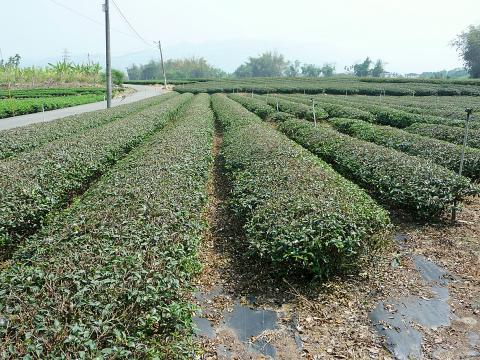
Photo: Steven Crook
From the late 1960s, the garden focused on propagating and studying rare or important tree species from the southern half of Taiwan. Between 1979 and 1995, the site was also used to raise peacocks, pheasants, sika deer and even sambar deer. To provide more space for trees, the birds were eventually sent to Fenghuanggu Bird and Ecological Park (國立自然科學博物館鳳凰谷鳥園生態園區) in nearby Lugu (鹿谷) and the larger animals were dispersed to other locations.
ENTERING THE GARDEN
The NTU Tropical Botanical Garden is open daily from 6am to 6pm. There’s no admission charge, and no facilities other than bathrooms. Information boards are lacking, but clear labels give Chinese and botanical names for most of the 500-plus tree and plant species here.
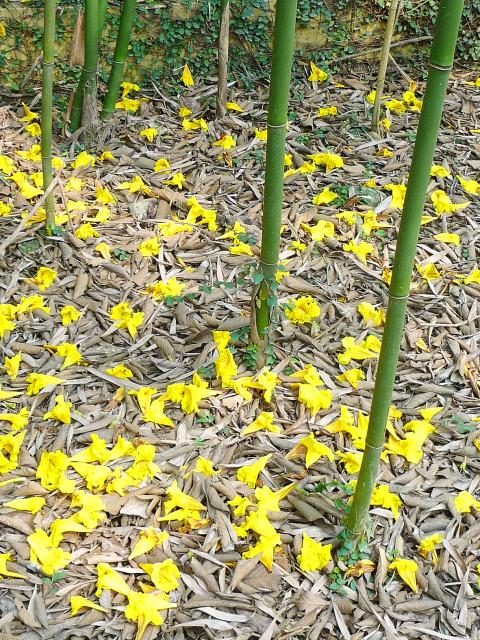
Photo: Steven Crook
The entrance is 155m above sea level and the entire facility covers 8.87 hectares, making it about half the size of Taipei Botanical Garden. The soil here is a sandy loam, ideal for the termites that are very evident.
A triangle of concrete pathways gives access to every part of the garden. Going off-trail, I walked straight into the web of a Golden Orb-weaver spider (Nephila pilipes). In Chinese, these creatures are called “man-faced spiders” (人面蜘蛛). I tried not to get too close to the dark dots and semi-circle on their yellow abdomens, which resemble eyes and a mouth — especially since the spider I was looking at was the size of a child’s hand.
Among birdwatchers, the garden is famed for its Malayan night herons. Treading quietly, I found myself within a few meters of an adult and a juvenile. They didn’t seem to mind me coming close enough to take photos. I disturbed a few lizards, but to my surprise, did not see a single squirrel.
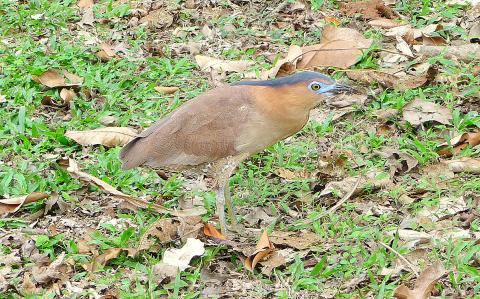
Photo: Steven Crook
Some of the trees planted in the garden are economically important, including at least three types of sandalwood. There are also species you’re likely to see in city parks. One specimen of Alstonia scholaris, known in both English and Chinese as the blackboard tree (黑板樹), is well over a meter in diameter.
Nearby, there’s a splendid weeping fig (Ficus benjamina var. comosa) that some might mistake for a banyan tree. A key difference between the two is that the weeping fig lacks aerial prop roots.
One part of the garden is currently cordoned off so that a dozen monitoring contraptions can do their work without disturbance. Some are nets; others are clear-sided cases that open and close automatically. I later learned that these devices measure leaf-fall as part of a research project assessing the impact of climate change.

Photo: Steven Crook
In the highest part of the garden (and the part closest to Freeway 3 — you’ll know from the traffic noise), the path is lined on both sides by mature Taiwan incense cedars (Calocedrus formosana). The wood of this endemic tree is popular because it’s strong and termite-resistant, and thus very suitable for furniture. As the name suggests, it can also be used in place of sandalwood to make incense.
Within the garden, every shade of green and brown is represented. A cluster of Araguaney trees (Tabebuia chrysantha) adds bright yellow flowers to the canopy and the ground. This species is common in parts of South America and is the national tree of Venezuela.
Eucalyptus is not native to the island, yet the specimen just behind the Taiwan incense cedars is perhaps the most productive gum tree I’ve ever encountered. There was an occasional, audible drip of dark fluid spattering onto the leaf litter at the base of the tree. Watching it ooze and trickle enthralled me. Nature at work!
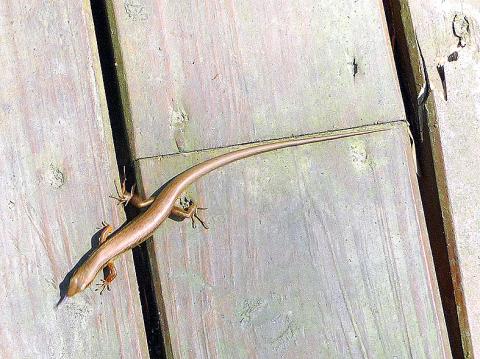
Photo: Steven Crook
Steven Crook has been writing about travel, culture, and business in Taiwan since 1996. Having recently co-authored A Culinary History of Taipei: Beyond Pork and Ponlai, he is now updating Taiwan: The Bradt Travel Guide.

The canonical shot of an East Asian city is a night skyline studded with towering apartment and office buildings, bright with neon and plastic signage, a landscape of energy and modernity. Another classic image is the same city seen from above, in which identical apartment towers march across the city, spilling out over nearby geography, like stylized soldiers colonizing new territory in a board game. Densely populated dynamic conurbations of money, technological innovation and convenience, it is hard to see the cities of East Asia as what they truly are: necropolises. Why is this? The East Asian development model, with

June 16 to June 22 The following flyer appeared on the streets of Hsinchu on June 12, 1895: “Taipei has already fallen to the Japanese barbarians, who have brought great misery to our land and people. We heard that the Japanese occupiers will tax our gardens, our houses, our bodies, and even our chickens, dogs, cows and pigs. They wear their hair wild, carve their teeth, tattoo their foreheads, wear strange clothes and speak a strange language. How can we be ruled by such people?” Posted by civilian militia leader Wu Tang-hsing (吳湯興), it was a call to arms to retake

Desperate dads meet in car parks to exchange packets; exhausted parents slip it into their kids’ drinks; families wait months for prescriptions buy it “off label.” But is it worth the risk? “The first time I gave him a gummy, I thought, ‘Oh my God, have I killed him?’ He just passed out in front of the TV. That never happens.” Jen remembers giving her son, David, six, melatonin to help him sleep. She got them from a friend, a pediatrician who gave them to her own child. “It was sort of hilarious. She had half a tub of gummies,
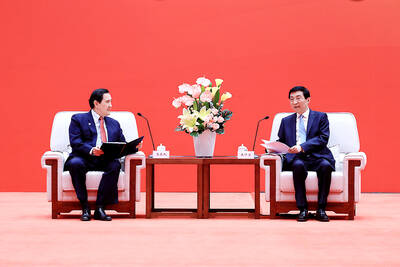
There is an old British curse, “may you live in interesting times,” passed off as ancient Chinese wisdom to make it sound more exotic and profound. We are living in interesting times. From US President Donald Trump’s decision on American tariffs, to how the recalls will play out, to uncertainty about how events are evolving in China, we can do nothing more than wait with bated breath. At the cusp of potentially momentous change, it is a good time to take stock of the current state of Taiwan’s political parties. As things stand, all three major parties are struggling. For our examination of the